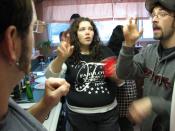When raising a deaf child, parents must decide how to educate that child. The task itself is not as simple as one may think, and each choice comes with at least one drawback. In the case of appropriate educational methods, there are two positions to choose from: American Sign Language (ASL) or Oralism (I have excluded all other possibilities for simple comparison). American Sign Language is a visual, gestural language used by many Deaf Americans today. One method of teaching, called Bilingual-Bicultural education, hopes to introduce congenitally born deaf children to ASL as a first language and follow with written English as a second language. There is not much focus on the spoken form of English. Bi-Bi looks to develop the deaf student's native language and use it as the foundation for learning English as a second language. Oralism, on the other hand, is an approach to teaching that focuses a great deal on auditory training and learning English both as a spoken and written language.
Bi-Bi is a better method of teaching deaf children because it supplies the deaf child with a true language background that matches their strictly visual world.
Supporters of Oralism claim that teaching speech is appropriate because it will help deaf children to acquire speech, but there is no sufficient data to support this. In order for Oralism to be "successful," the child must begin oral rehabilitation before the critical age for language development occurs, usually around 18 months to 36 months (Solomon 42). During this time, the child goes through extensive auditory training and speech development with no visual stimuli. Oralists say that visual stimuli will only slow down speech acquisition. They believe that children who learn ASL will close themselves off to spoken English because the visual language is easier for them...


